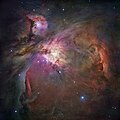
Sınaq göstərişi ölçüsü: 600 × 600 piksel. Digər ölçülər: 240 × 240 piksel | 480 × 480 piksel | 768 × 768 piksel | 1.024 × 1.024 piksel | 2.048 × 2.048 piksel | 18.000 × 18.000 piksel.
Faylın orijinalı (18.000 × 18.000 piksel, fayl həcmi: 36,87 MB, MIME növü: image/jpeg)
Faylın tarixçəsi
Faylın əvvəlki versiyasını görmək üçün gün/tarix bölməsindəki tarixlərə klikləyin.
| Tarix/Vaxt | Miniatür | Ölçülər | İstifadəçi | Şərh | |
|---|---|---|---|---|---|
| hal-hazırkı | 10:14, 13 iyul 2016 |  | 18.000 × 18.000 (36,87 MB) | Fabian RRRR | Higher quality: https://cdn.spacetelescope.org/archives/images/large/heic0601a.jpg |
| 14:56, 21 iyun 2009 |  | 18.000 × 18.000 (23,67 MB) | Tryphon | Better quality. | |
| 22:09, 11 sentyabr 2006 |  | 18.000 × 18.000 (18,41 MB) | HInBC | '''Please note that a lower resolution(1/9th the size) version of this image is available at Image:Orion Nebula - Hubble 2006 mosaic.jpg due to the fact that many computers cannot load the full resolution image.''' == Summary == {{Information |Desc |
Faylın istifadəsi
Aşağıdakı 4 səhifə bu faylı istifadə edir:
Faylın qlobal istifadəsi
Bu fayl aşağıdakı vikilərdə istifadə olunur:
- af.wikipedia.org layihəsində istifadəsi
- ar.wikipedia.org layihəsində istifadəsi
- مجرة
- نجم
- تكون النجوم
- ويكيبيديا:أسبوع الويكي/فلك
- ويكيبيديا:أسبوع الويكي/مواضيع أسبوع الويكي/2009
- الجبار (كوكبة)
- سديم إشعاعي
- سديم الجبار
- ويكيبيديا:أسبوع الويكي/2009/49
- مستخدم:عباد ديرانية
- مسييه 43
- ويكيبيديا:أسبوع الويكي/مواضيع أسبوع الويكي/2010
- بوابة:علم الفلك/صورة الأسبوع/أرشيف
- ويكيبيديا:أسبوع الويكي/2010/36
- سحابة الجبار الجزيئية
- مستخدم:عباد ديرانية/قوالب
- ويكيبيديا:صور مختارة/الفضاء والكون/نظرة إلى الأعلى
- قائمة فهرس مسييه
- بوابة:علم الفلك/صورة مختارة
- ويكيبيديا:ترشيحات الصور المختارة/فسيفساء سديم الجبار
- ويكيبيديا:صورة اليوم المختارة/نوفمبر 2017
- قالب:صورة اليوم المختارة/2017-11-16
- بوابة:علم الفلك/صورة مختارة/43
- ويكيبيديا:صورة اليوم المختارة/نوفمبر 2021
- قالب:صورة اليوم المختارة/2021-11-18
- ويكيبيديا:صورة اليوم المختارة/فبراير 2025
- قالب:صورة اليوم المختارة/2025-02-15
- ar.wikiversity.org layihəsində istifadəsi
- arz.wikipedia.org layihəsində istifadəsi
Bu faylın qlobal istifadəsinə baxın.



